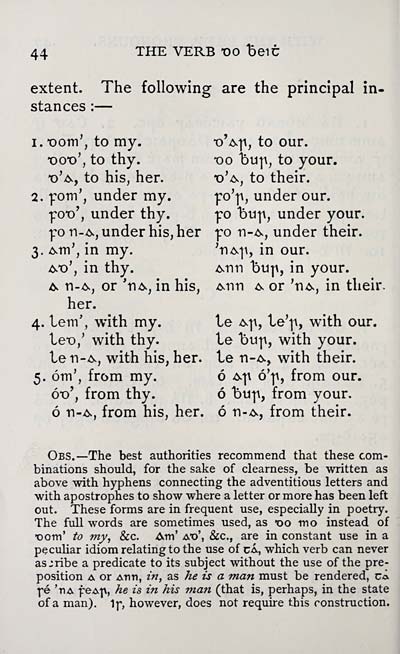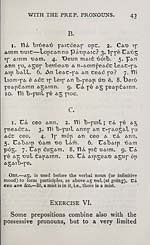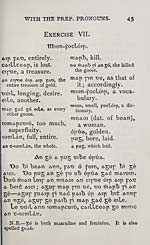Download files
Complete book:
Individual page:
Thumbnail gallery: Grid view | List view

44
THE VERB t)0 beiC
extent. The following are the principal in-
stances : —
i. •corn', to my.
•00*0', to thy.
•o'a, to his, her.
2. forti', under my.
■pco', under thy.
-p n-A, under his, her
3. Any, in my.
a*o', in thy.
a n-A, or 'nA, in his,
her.
4. tern', with my.
Le*o/ with thy.
te n-A, with his, her.
5. ótti', from my.
óx)', from thy.
ó n-A, from his, her.
■o'fcji, to our.
•oo bun, to your.
•o'a, to their.
•jro'-p, under our.
■po bun, under your.
ipo n-A, under their.
'ti^H, in our.
Ann bun, in your.
Ann a or 'ua, in their.
te An, ^ e Y> with our.
te bun, with your,
te n-A, with their.
ó An o'n, from our.
ó bun, from your,
ó n-A, from their.
Obs.— The best authorities recommend that these com-
binations should, for the sake of clearness, be written as
above with hyphens connecting the adventitious letters and
with apostrophes to show where a letter or more has been left
out. These forms are in frequent use, especially in poetry.
The full words are sometimes used, as "oo tno instead of
•ootn' to my, Sec. Am' at>\ &c, are in constant use in a
peculiar idiom relating to the use of cÁ, which verb can never
ascribe a predicate to its subject without the use of the pre-
position a or Ann, in, as he is a man must be rendered, zo.
fé 'tiA feAn, he is in his man (that is, perhaps, in the state
of a man). 1r, however, does not require this construction.
THE VERB t)0 beiC
extent. The following are the principal in-
stances : —
i. •corn', to my.
•00*0', to thy.
•o'a, to his, her.
2. forti', under my.
■pco', under thy.
-p n-A, under his, her
3. Any, in my.
a*o', in thy.
a n-A, or 'nA, in his,
her.
4. tern', with my.
Le*o/ with thy.
te n-A, with his, her.
5. ótti', from my.
óx)', from thy.
ó n-A, from his, her.
■o'fcji, to our.
•oo bun, to your.
•o'a, to their.
•jro'-p, under our.
■po bun, under your.
ipo n-A, under their.
'ti^H, in our.
Ann bun, in your.
Ann a or 'ua, in their.
te An, ^ e Y> with our.
te bun, with your,
te n-A, with their.
ó An o'n, from our.
ó bun, from your,
ó n-A, from their.
Obs.— The best authorities recommend that these com-
binations should, for the sake of clearness, be written as
above with hyphens connecting the adventitious letters and
with apostrophes to show where a letter or more has been left
out. These forms are in frequent use, especially in poetry.
The full words are sometimes used, as "oo tno instead of
•ootn' to my, Sec. Am' at>\ &c, are in constant use in a
peculiar idiom relating to the use of cÁ, which verb can never
ascribe a predicate to its subject without the use of the pre-
position a or Ann, in, as he is a man must be rendered, zo.
fé 'tiA feAn, he is in his man (that is, perhaps, in the state
of a man). 1r, however, does not require this construction.
Set display mode to: Large image | Transcription
Images and transcriptions on this page, including medium image downloads, may be used under the Creative Commons Attribution 4.0 International Licence unless otherwise stated. ![]()
| Early Gaelic Book Collections > Blair Collection > Treas leabhar Gaedhilge > (50) |
|---|
| Permanent URL | https://digital.nls.uk/82321986 |
|---|
| Description | A selection of books from a collection of more than 500 titles, mostly on religious and literary topics. Also includes some material dealing with other Celtic languages and societies. Collection created towards the end of the 19th century by Lady Evelyn Stewart Murray. |
|---|
| Description | Selected items from five 'Special and Named Printed Collections'. Includes books in Gaelic and other Celtic languages, works about the Gaels, their languages, literature, culture and history. |
|---|

